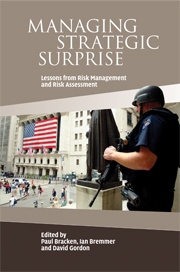Book contents
- Frontmatter
- Contents
- List of figures
- List of tables
- List of contributors
- Acknowledgements
- 1 Introduction
- 2 How to build a warning system
- 3 Intelligence management as risk management: the case of surprise attack
- 4 Nuclear proliferation epidemiology: uncertainty, surprise, and risk management
- 5 Precaution against terrorism
- 6 Defense planning and risk management in the presence of deep uncertainty
- 7 Managing energy security risks in a changing world
- 8 What markets miss: political stability frameworks and country risk
- 9 The risk of failed-state contagion
- 10 Conclusion: managing strategic surprise
- Index
10 - Conclusion: managing strategic surprise
Published online by Cambridge University Press: 14 May 2010
- Frontmatter
- Contents
- List of figures
- List of tables
- List of contributors
- Acknowledgements
- 1 Introduction
- 2 How to build a warning system
- 3 Intelligence management as risk management: the case of surprise attack
- 4 Nuclear proliferation epidemiology: uncertainty, surprise, and risk management
- 5 Precaution against terrorism
- 6 Defense planning and risk management in the presence of deep uncertainty
- 7 Managing energy security risks in a changing world
- 8 What markets miss: political stability frameworks and country risk
- 9 The risk of failed-state contagion
- 10 Conclusion: managing strategic surprise
- Index
Summary
At the outset we acknowledged the exceedingly ambitious goal of attempting to use risk management in international affairs. Our take on this was that trying to “solve” the problems of warning, WMD proliferation, energy, etc., using risk management didn't make sense as a standard to judge performance by. The idea of an all-encompassing grand solution to any of these problems is unlikely to be a fruitful approach because they involve many broader political and economic considerations.
Instead of trying to solve these problems our goal was more modest. Having a productive conversation about them, one that specified the likelihoods and consequences of different developments, would go a long way to improving how we handle them. This “management” approach, rather than a solutions approach, fits the complex character of the problems. Our argument, in a nutshell, was that some framework was needed in order to have this productive conversation. Without such a framework the conversation would wander all over the place, and would have little prospect for mobilizing consistent attention in a useful way.
Of course, there are many frameworks that one could use to have this conversation. Risk management is distinguished from other approaches to making decisions, such as using abstract ideals (“stability,” “democracy”) as policy drivers. And it differs from relying on rules (“do not reward bad behavior”) to guide actions. Ideals are fine, but absent consideration of the likelihood of their success, or their costs and consequences, they can lead to catastrophic results. Rules also have their place.
- Type
- Chapter
- Information
- Managing Strategic SurpriseLessons from Risk Management and Risk Assessment, pp. 302 - 310Publisher: Cambridge University PressPrint publication year: 2008



